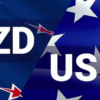
A turbulent week in global markets is set to close with the release of the highly anticipated US Nonfarm Payrolls (NFP) report for July, scheduled for Friday at 12:30 GMT. Published by the Bureau of Labor Statistics (BLS), the report provides a monthly snapshot of the US labor market—tracking employment gains, wage growth, and the unemployment rate—key indicators closely monitored by the Federal Reserve (Fed).
Typically released on the first Friday of each month, the NFP report plays a significant role in shaping the Fed’s monetary policy decisions. However, with the Fed announcing its latest policy decision this past Wednesday—leaving interest rates unchanged—the immediate impact of the July NFP may be somewhat muted.
Job Growth Expected to Slow
Market expectations suggest the US economy added 110,000 new jobs in July, a noticeable decline from the 147,000 recorded in June. At the same time, the unemployment rate is forecast to tick higher, from 4.1% to 4.2%.
Wage inflation remains a key focus, with Average Hourly Earnings expected to rise 0.3% month-on-month and 3.8% year-on-year, slightly above the respective 0.2% and 3.7% increases posted in June. These figures suggest moderate but persistent upward pressure on wages.
Mixed Labor Market Signals Ahead of NFP
Despite the softer NFP forecast, recent labor data has painted a mixed picture. According to the JOLTS report, job openings fell to 7.43 million in June—below the 7.77 million (revised) seen in May and short of the 7.55 million market estimate.
On a more positive note, the ADP Employment Change report showed private employers added 104,000 new jobs in July. Additionally, the ADP revised June’s job losses from -33,000 to -23,000, providing some reassurance about underlying labor demand.
Fed Holds Rates Steady, Downplays Pressure
At its July meeting, the Federal Reserve opted to hold the benchmark interest rate steady in the 4.25%–4.50% range. However, two members of the Federal Open Market Committee (FOMC)—Christopher Waller and Michelle Bowman—dissented, advocating for a rate cut.
Fed Chair Jerome Powell defended the decision, citing inflation that remains above the central bank’s 2% target and a still-tight labor market. He emphasized the Fed’s readiness to respond if needed but reiterated that it would not yield to political pressure—including persistent calls from President Donald Trump for lower interest rates. Powell also noted that the inflationary effects of tariffs are still unclear.
Following Powell’s remarks, the probability of a rate cut in September declined sharply—from nearly 60% to around 43%, according to the CME FedWatch Tool.
US Economy Expands Sharply in Q2
In a further sign of resilience, the US GDP flash estimate for Q2 showed the economy grew at a 3% annualized rate—a sharp rebound from the 0.5% contraction in Q1 and stronger than the 2.4% consensus forecast.
Trade Tensions and EUR/USD Implications
Market sentiment this week was also influenced by mixed signals on trade. Optimism emerged early in the week after the US reached tentative trade agreements with both the European Union and Japan, while talks with China reportedly continue.
However, concerns resurfaced mid-week as deals with Canada, Australia, and India remained unresolved. President Trump escalated tensions further by announcing a 50% tariff on Brazilian imports and a sweeping 50% duty on semi-finished and copper-intensive products, effective August 1.
Despite the uncertain trade landscape, the US Dollar (USD) has maintained its strength. The EUR/USD pair currently trades near 1.1400, with further direction likely hinging on Friday’s NFP data.
A stronger-than-expected jobs report, with solid job creation and steady unemployment, would likely reinforce the Fed’s current policy stance and bolster the USD. Conversely, a weak headline figure coupled with a rising jobless rate could pressure the Greenback.
That said, even a moderate increase in job creation paired with a slight uptick in the unemployment rate may still be interpreted as broadly positive for the USD, given the context of overall economic strength.
Technical View: EUR/USD Faces Downside Risk
According to Valeria Bednarik, Chief Analyst at FXStreet, the EUR/USD pair is trading at its lowest in over a month, having dropped approximately 400 pips from its July peak of 1.1830. She describes the USD’s recent rally as a necessary correction after five consecutive months of Dollar weakness.
Bednarik notes that a robust NFP print could push EUR/USD below the 1.1400 mark, potentially extending the decline toward 1.1340—a support level from June—and possibly even 1.1280.
However, she cautions that for the pair to recover its bullish momentum, it would need to climb above 1.1470. Even then, a weekly close near 1.1550 would be required to signal a possible bottom, with the broader risk still leaning to the downside in the medium term.









